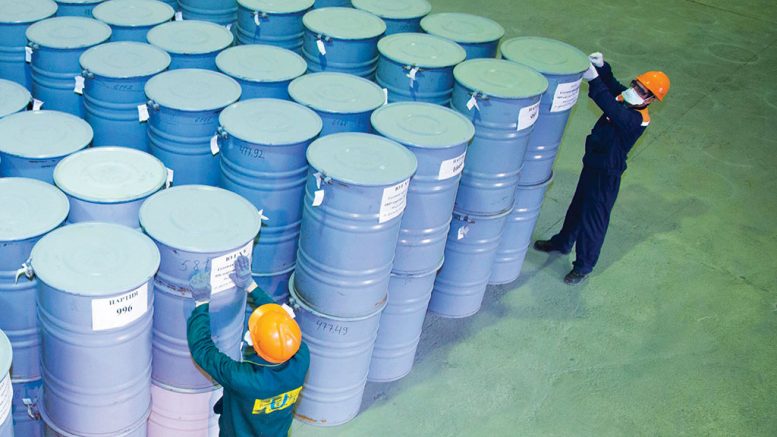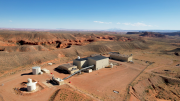The uranium spot price has hovered around US$25 ($32.86) per lb. over the better part of the last year and long-term pricing is at the US$32 per lb. level. The prolonged bear market and weak macro-environment continue to erode investor confidence in the primary uranium producers, which in some cases have curtailed output to trim operating costs and stem losses.
Market stresses on uranium producers have boosted the popularity of investment alternatives in the energy metal space, specifically, physical uranium-holding companies such as Uranium Participation (TSX: U) and Yellow Cake (US-OTC: YLLXF).
These companies offer investors exposure to the physical commodity — uranium oxide (U3O8) concentrates — through their direct purchase of material from primary producers and the holding of it in inventory for future resale. These companies are leveraged to the uranium price without taking on the risks associated with mining the commodity, including permitting, resource and reserve development, and operations.
Uranium Participation is the leader in the niche sector. Upon listing through a $90-million initial public offering (IPO) in 2005, the company appointed Denison Mines (TSX: DML) as manager to handle and arrange its U3O8 purchasing and sales with a mandate to allocate at least 85% of its aggregate gross proceeds towards uranium purchases.
The company undertook initial purchase agreements for 1.85 million lb. U3O8 at an average price of US$27.87 per lb. and secured licensed storage facilities for its physical holdings in Canada, France, the U.K. and the United States.
Uranium Participation now reports 18.1 million lb. of U3O8 equivalent in its holdings for a net asset value of $587 million at current uranium prices. Nearly 94% of its gross proceeds are invested in uranium.
The newest player in the uranium-holding company space is Yellow Cake, which launched mid-2018 through a US$200-million ($263-million) initial public offering (IPO) in London that was anchored by a 9.9% lead order from Uranium Royalty (TSXV: URC). The company added another US$34 million to its coffers in mid-2019 in a subsequent financing.
Yellow Cake’s launch was based on securing a long-term strategic supply agreement to buy U3O8 from Kazakhstan-producer Kazatomprom, the world’s largest uranium producer. Following its IPO, Yellow Cake bought 8.4 million lb. U3O8 from the Central Asian miner at an average cost of US$21.10 per pound. The purchase represented one-quarter of Kazatomprom’s annual output in 2018.

Uranium drums at Cameco’s 83%-owned Key Lake uranium mill in 2014. Credit: Cameco.
The agreement with Kazatomprom gives Yellow Cake the right to purchase up to US$100 million of U3O8 at the spot price each year from 2019 to 2027.
In its latest reporting, Yellow Cake’s holdings are tabled at just over 9.6 million lb. U3O8 that are stored at Cameco’s (TSX: CCO; NYSE: CCJ) Port Hope/Blind River facility in Ontario.
Uranium Participation and Yellow Cake are not the only companies buying U3O8 in the spot market. Some primary producers get supply to offset production closures and deferrals at their mines due to weak commodity prices.
Cameco has been an active U3O8 buyer since its closure of the McArthur River mine and Key Lake processing plant in early 2018, and the suspension of operations at its Rabbit Lake, Crow Butte and Smith Ranch–Highland mines in 2016. The company guided it would make spot market purchases of 21 million to 23 million lb. in 2019 to meet sale commitments and maintain working inventory, and would likely continue the program in 2020.
The sector has seen other major producers take significant production offline in reaction to the weak uranium price.
At the end of 2017, Kazatomprom announced it would lower its uranium production 20% for three years to address oversupply. It recently extended its production curtailment through 2021. Even with these cutbacks, the company will keep its top producer status, with annual output of 45 million to 50 million lb. U3O8.
In mid-2018, Australian-listed uranium miner Paladin Energy (ASX: PDN) shuttered operations at its 75%-owned Langer Heinrich mine in Namibia, taking 5.2 million lb. U3O8 offline annually. Paladin recently announced the launch of a technical study to develop an optimized restart plan for the mine that envisions annual production of up to 6.5 million lb. U3O8 at a targeted all-in sustaining cost of $39.43 per pound.
However, Paladin’s plans come at a cost. The company estimates capital of US$80 million ($105 million) in capital — roughly split between plant repair and improvement, and working capital — will help restart production at Langer Heinrich to historic levels of 5.2 million lb. annually. Boosting output to the 6.5 million lb. level could require another US$30 million ($39.43 million in capital expenses.
Despite these recent production cutbacks, the market remains guarded on uranium’s near- to medium-term outlook due to ongoing oversupply concerns and robust inventories with end-users and customers.
In its January 2020 commodity fundamentals review, Scotiabank forecasts average uranium spot prices between 2020 and 2023 of US$30 per lb., US$35 per lb., US$40 per lb. and US$40 per lb., and said the metal’s upside potential appears capped in the medium-term based on the potential reversal of production curtailments. The bank says uranium could remain below its long-term incentive price of US$50 per lb. until 2028.
At press time, Uranium Participation traded at $4.02 per share, near the low of its 52-week trading range of $5.14 to $3.78, giving the company a $555-million market capitalization.
Orest Wowkodaw, a mining analyst at Scotiabank, has an “outperform rating” on Uranium Participation and a $5.25-per-share target price.
“Our net asset value per share increased by 5% to $5.25 per share (from $4.99), driven by an increase in our 12-month-out U3O8 price forecast to US$32 per lb. from US$30 per lb.,” he wrote in Scotiabank’s commodity fundamentals review.
But the analyst’s outlook for uranium remains cautious. “We expect uranium prices to slowly recover and remain well below long-term incentive levels for several more years,” Wowkodaw says. “Although several large production cuts have shifted the market from significant surplus to a meaningful deficit, we forecast a largely balanced market once idled capacity inevitably returns. We anticipate the market to finally enter a sustainable structural deficit late this decade.”
Shares of Yellow Cake recently closed at £1.95 ($3.35) per share, near the lower end of its 52-week trading range of £2.42 ($4.16) to £1.80 ($3.09) — giving the company a £172-million ($296-million) market capitalization.






Be the first to comment on "Uranium holding companies offer alternative to producers"